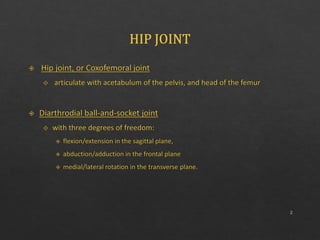1- HIP JOINT (1).pptx
- 1. 1
- 2. 2
- 3. 3
- 4. 5
- 5. 6
- 6. 7
- 7. 8
- 8. 9
- 9. 10
- 10. ANGLE OF INCLINATION OF THE FEMUR 11
- 11. 12
- 12. 13
- 13. 14
- 14. 15
- 15. 16
- 16. 17
- 17. 18
- 18. 19
- 19. 20
- 20. 21
- 21. 22
- 22. 23
- 23. 24
- 29. 30
- 32. 33
- 33. 34
- 34. 35
- 35. 36
- 36. 37
- 37. 38
- 39. 40
- 40. 41
- 41. 42
- 42. 43
- 43. 44
- 45. 46
- 46. 47
- 47. 48
- 48. 49
- 49. 50
- 50. 51
- 51. 52
- 52. 53
Editor's Notes
- ilium, the ischium, and the pubis
- The angle of inclination of the femur changes across the life span, being substantially greater in infancy and childhood (see Fig. 10-2B) and gradually declining to about 120 in the normal elderly person.
- The acetabulum does not fully cover the head superiorly, and the anterior torsion of the femoral head (angle of torsion) exposes a substantial amount of the femoral head’s articular surface anteriorly. Articular contact between the femur and the acetabulum can be increased in the normal non–weight-bearing hip joint by a combination of flexion, abduction, and slight lateral rotation (see Fig. 10-9B). This position (also known as the frog-leg position) corresponds to that assumed by the hip joint in a quadruped position and, according to Kapandji, 9 is the true physiologic position of the hip joint
- The ligament is a triangular band attached at one end to both sides of the peripheral edge of the acetabular notch. The ligament then passes under the transverse acetabular ligament (with which it blends) to attach at its other end to the fovea of the femur; thus, it is (Fig. 10-11)
- checks extension, adduction (superior fibers), and abduction (inferior fibers). In addition, because this ligament limits hip extension, it allows maintenance of the upright posture by reducing the need for muscle contractions
- Optimal articular contact occurs with combined flexion, abduction, and lateral rotation
- has less reinforcement and thus more potential for failure. The zone of weakness of the femoral neck is particularly susceptible to the bending forces across the area and can fracture either when forces are excessive or when compromised bony composition reduces the tissue’s ability to resist typical forces



















































